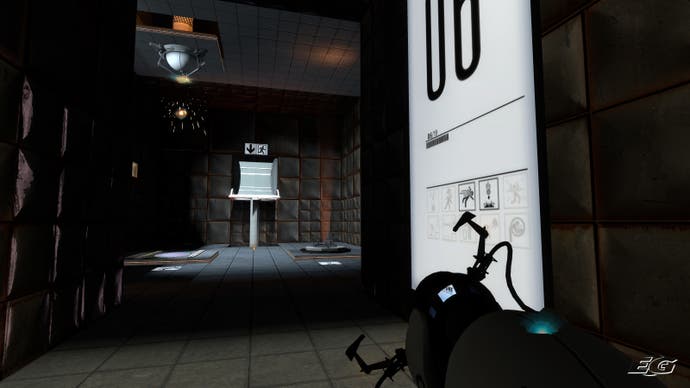Portal
I can't go if someone's watching.
Kim Swift gives me performance anxiety. "Now you're thinking with portals," says Portal. Unfortunately I'm not. It's a flaw in Valve's preview approach. Most scenarios in Portal have to be solved by firing a portal entrance and a portal exit at different bits of wall. You then either enter one to exit through the other, or move an object through. And if you can't immediately see what you're meant to do, every second lost to the solution's pursuit gives the invisible man chiselling "dunce" on your pride the chance to add a flourish. By now mine's backlit serif, and twinned with a town in Castilla-La Mancha. Freed of the pressure of having the lead designer sat behind you the entire time you play, you can probably think more clearly. The impossible will be easy. At least to start.
Portal begins by demonstrating through hands-on experimentation how portals work, and which surfaces you can use. When you first gain the Aperture Science Handheld Portal Device, or the "portal gun", you can only place one portal, with the other fixed. It doesn't take long to grasp. "When we introduce a new mechanic, we'll playtest that and see if the player got it right away, if he was really confused, or just didn't get it at all, we have to go back to the drawing board," says Swift. "We just kept iterating on that until we found a good way to train players. Now we're able to teach them really complex mechanics and tricks." The benefits of this approach are apparent throughout. By the time the second portal is introduced, you're well into your stride, and happy to start firing them off. Left-click for blue, right-click for orange. Another example is the "funnelling" toggle in the options menu. Enabled, the game gives you a bit of help jumping or bouncing things through portals, without stopping you dead because you snagged the boundary by a pixel or two. Good work, playtesters.
But of course you're a test subject, not a student, and you'll certainly feel like Pavlov's dog from time to time. When you start to redirect floating orange orbs ("High Energy Pellets"), which spawn, bounce off walls, and need to be threaded through portals to reach a switching device that activates a moving platform, you get ahead of yourself, channelling techniques you've glimpsed in trailers. You place the first portal, let an orb float into it, and then try and move it room by room back to its destination. Except there's a black-walled, L-shaped section that you obviously can't traverse. The penny drops. You can just pop the exit portal over the destination device's head and ignore all the rooms in-between. You need to free your head from the assumption that distance means anything. So, now we're thinking with portals. This is a game with lots of "duh" moments, I point out. Swift laughs. With me, I like to think.

Then I meet turret guns. The level is criss-crossed with red laser beams, indicating where their sights are targeted, and they have a generous firing arc. For them, anyway. Move into it and they will adjust and hit you - high, low, left or right. You won't survive long if they do, and the bullets thudding into your body restrict your movement. The obvious response is to knock them over another way, which deactivates them, and the solution requires the usual lateral thinking. Or seems to. There are usually clean solutions (drop a crate onto its head, drop behind it and physically knock it over, use something as a shield to move closer to it), but Portal doesn't legislate against people who want to run rather than think. "Really fast, crazy first-person shooter guys can just storm through," says Swift. "It's somewhat analogous to Ravenholm [in Half-Life 2]," Doug Lombardi, now also spectating, elaborates. "You could have bolted through that pretty quickly with the shotgun, or you could spend a long time splitting zombies with sawblades. We try to play to many different players' interests."
Half-Life 2 also handled moments of levity with greater maturity than most first-person shooters (the interaction between Lamarr and Kleiner, for example), and Portal's the same, although its approach is deadpanning computers. "You subject-name-here must be the pride of subject-hometown-here," says the robotic female narrator (whose inflections, I notice on my dictaphone, are not unlike Swift's). The smirk remains even when you're frustrated, with the turrets a particular highlight. "I don't hate you," one of them says reassuringly as I use it to shield me from its friend. Equally offbeat are the scrawls left by former test subjects, reminiscent of the lines around the margins in the film Cube. One dark chamber behind a seemingly wrenched-off panel insists: "The cake is a lie." The shades of Psychonauts are down to Erik Wolfpaw (one half of Old Man Murray), who worked on the dialogue for both this and that.

By now momentum is starting to play a role in the puzzles you approach. As the narrator helpfully points out, momentum is conserved between portals. "In layman's terms, speeding thing goes in, speedy thing comes out." You can use it to catapult yourself across pits you wouldn't otherwise be able to cross, and to do the same with crates and turrets. This sort of thing could give players the scope for shortcutting their way to the solution.

